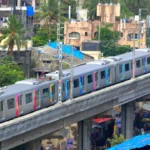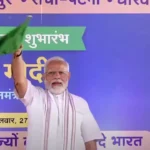Mumbai, a city well-known for its busy local train system, offers an intriguing opportunity to observe commuter behavior as they move from metro to suburban trains. This essay explores the fundamental elements that influence the dynamics of urban transportation in Mumbai by examining the glaring disparities in passenger behavior at these various transit systems. The dissimilar behaviors, which range from the disorderly suburban train stations to the orderly lines at metro platforms, are indicative of the social, cultural, and economic subtleties of the city.
Modern Comfort vs. Overcrowding
According to observations made during 8 hours at the Ghatkopar Metro Station and the connected suburban railway station, there are distinct characteristics that influence the behavior of passengers on metro trains and suburban railroads. The contemporary, comfortable travel in the metro and the issues with congestion in local trains, respectively, were the reasons given by Mahesh Satam and Suresh Nathani for the discrepancy. While Sohan Jain applauded the tighter admission to minimize unnecessary overcrowding, Suhani Joshi highlighted the peaceful entertainment provided by the metro.
Also Read: Gurugram Metro Project Effects on Urban Revitalization and Real Estate Prices
Cultural Variations
The long-standing social and cultural subtleties are brought to light by the commuter customs seen on Mumbai’s suburban and metro trains. The metro, with its state-of-the-art facilities and methodical operations, promotes cultural and subject etiquette, as demonstrated by its orderly lines and well-maintained systems. Conversely, the local rail community captures the vibrant energy of Mumbai, which is defined by disorder, fast pace, and adaptability.
Disparities in Cost and Service
According to Mansoor Umar Darvesh of the Passengers and Traffic Relief Association, the significant financial distinction between suburban and metro trains is the reason for the behavioral discrepancy. He brought out the suburban railway system’s perceived inferiority in service as opposed to the metro’s better-organized offerings.
Impact of Technology
Additionally, travelers mentioned how technology helps people behave better. By changing commuter behavior, the metro’s smart entrance and exit technology lowers the number of trips made without a ticket. Siddhesh Desai emphasized the beneficial effects of smart systems and emphasized how improved technology affects passenger behavior and comfort.
Also Read: Mumbai Metro’s Expansion Plans: BKC to Worli Link to Commence Operations in 2024
Passenger Volume and Information
Railway officials offered their viewpoint, pointing to the substantial volume of passengers that use the metro and the suburban train station in Ghatkopar. The information provided insight into the daily foot traffic and usage patterns, highlighting the enormous number of passengers utilizing various transit systems.
Cultural Dynamics
Dr. Harish Shetty, a psychiatrist, delved into the cultural dynamics that contribute to the divergent atmospheres on metro and suburban trains. He discussed the cultural phenomenon of spitting, commonplace in local trains however absent at the metro, attributing it to a sense of deterrence and punishment in the metro environment.
Perceived Sophistication
Dr. Shetty highlighted the notion that passengers need to fit the perceived sophistication of the transportation gadget they are the usage of. This cultural element impacts conduct, with nearby trains visible as more informal and the metro perceived as upmarket and cutting-edge.
Socioeconomic Threads
Transport experts and Mohammad Afzal emphasized the socioeconomic threads woven into commuter conduct. The improved fares of metros position them as an image of affluence, growing an evaluation with suburban trains that serve as a mass transit option for diverse societal strata.
Conclusion
In the world of Mumbai’s city transportation, the contrasting behaviors on metro and suburban trains paint a bright image of the city’s dynamic commuter tradition. From the bustling chaos of local trains to the disciplined order of metro stations, the social, cultural, and monetary factors intertwine, shaping the manner Mumbaikars navigate and understand their various transit options.











[…] Why Do Residents of Mumbai Act Differently In Local And Metro Trains? […]